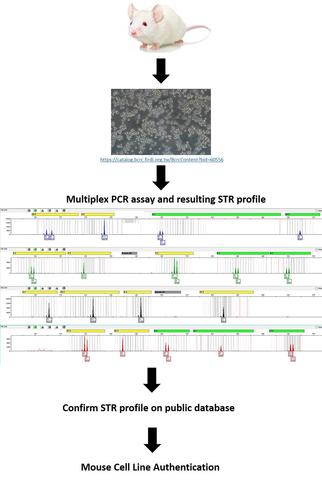Summary
Cells derived from different organisms and tissues have been established and are used in bioresearch and for the production of complex biological products. The cell lines can be grown in labs for extended periods, but changes in the DNA sequence and biological responses of the cells can occur. The changes in the cell lines during culturing or inadvertent mixing or mislabeling cannot be readily identified by their appearance under a microscope. A major issue has continued to plague the scientific community for over 50 years: cell line contamination and misidentification. Human cell lines can be identified by existing multiplex polymerase chain reaction (PCR) assays that target short tandem repeat (STR) markers in DNA that are used as fingerprints for authentication. Methods to authenticate nonhuman cell lines are lacking. Our efforts have focused on developing methods for authentication of important nonhuman cell lines to achieve measurement assurance of their use.
Description

Figure 1. Top to Bottom: BALB/c mouse; phase microscopy image of A20 mouse cell line (courtesy of Bioresource Collection and Resource Center (BCRC); Electropherogram of the A20 STR profile; Database for A20 mouse STR profiles can be found at NCI BioSample and Cellosaurus.
Cell Line Authentication – The scientific community has responded to the misidentification of human cell lines with validated methods to authenticate these cells; however, there are few assays available for nonhuman cell line identification. We have developed multiplex polymerase chain reaction (PCR) assays that target short tandem repeat (STR) markers in DNA. The STR markers are highly polymorphic (many differences in repeat length) and are used to fingerprint the cell lines for authentication. We first developed a multiplex PCR assay to authenticate African green monkey cell lines and determine contamination by human cell lines (BMC Biotechnology 2011, 11:102).
Development of Mouse Cell Line STR Multiplex Assays and a Consortium for Validation of the Measurement Method
Mice have been the most popular laboratory animal, widely used for genetic and basic research studies, resulting in mouse cell lines being the most numerous and important cell lines second to human cell lines. We have developed a multiplex PCR assay that targets tetranucleotide repeats in the mouse genome consisting of primers that amplify eighteen mouse STR markers.
Initial studies of the mouse multiplex assay resulted in unique profiles from fifty inbred mice which were used to determine the allele distribution for each STR marker. Correlations between allele fragment length and repeat number were confirmed with Sanger sequencing. STR genotypes for L929 and NIH3T3 cell lines were shown to be stable for at least 6 months with increasing passage numbers as there were no significant differences in fragment length in samples of low passage when compared to high passage samples. In order to detect cell line contaminants, primers for two human STR markers were incorporated into the multiplex assay to facilitate the detection of human and African green monkey DNA. Adoption of this assay would increase confidence in studies using mouse cell lines and could ultimately save time and reduce costs by identifying misidentified or contaminated cell lines in advance.
To help address this challenge, NIST and the American Type Culture Collection (ATCC) partnered to establish the Mouse Cell Line Authentication Consortium to test and validate NIST’s patented authentication method . The consortium’s goals included the following:
- Test the effectiveness of the mouse STR markers
- Create a public STR profile database for mouse cell lines
- Publish interlaboratory validation study results
NIST Reference Material for Measurement Assurance of the Mouse Authentication Assay
NIST and ATCC worked together under a Cooperative Research and Development Agreement (CRADA) to develop tools to create a mouse allelic ladder. An allelic ladder is needed for accurate allele call determination using the validated assay and STR markers tested in the consortium interlaboratory study. The allelic ladder will be made publicly available as a NIST Reference Material allowing increased confidence in the use of the STR assay for cell line authentication.
MAJOR ACCOMPLISHMENTS
U.S. patent (No. 9,556,482) for an authentication method using NIST-identified short tandem repeat (STR) markers.
U.S. patent (No. 10,745,753) published for additional STR markers for the mouse cell line authentication method.
NCBI BioSample Database entry for mouse STR profiles.
Publication of the interlaboratory results (PLOS ONE 14(6): e0218412)

